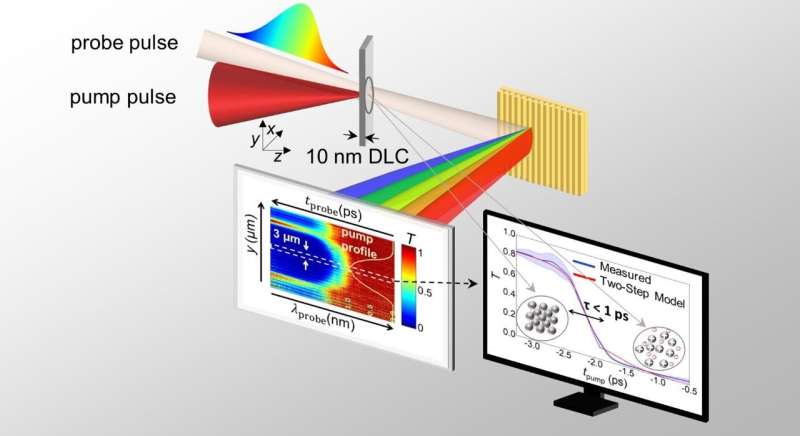
Both single-shot probing technique and modeling approach for revealing the ultrafast laser-induced solid-to-plasma transition. Credit: TranSpread
The interaction of solids with high-intensity ultra-short laser pulses has enabled major technological breakthroughs over the past half-century. On the one hand, laser ablation of solids offers micromachining and miniaturization of elements in medical or telecommunication devices. On the other hand, accelerated ion beams from solids using intense lasers may pave the way for new opportunities for cancer treatment with laser-based proton therapy, fusion energy research, and analysis of cultural heritage.
However, challenges still need to be overcome in order to push ahead laser ablation performance to the nanometer scale, and to bring laser-driven ion acceleration to industry and medical use.
During the interaction of an ultrashort laser pulse with a solid target, the latter evolves to an ionized state or plasma over an extremely short time period (less than a picosecond [ps]), where multiple of complex and coupled physical processes take place, while their interplay is still not fully understood.
Due to the ultrafast target evolution, the initial stage of the interaction, i.e., plasma formation, is hardly accessible in experiments. Hence, this ultrafast solid-to-plasma transition, which sets the initial conditions for subsequent processes like ablation or particle acceleration, has so far been treated by rough assumptions in most of the numerical models that describe such an interaction.
In a new paper published in Light: Science & Applications, an international team of scientists, including Yasmina Azamoum and Malte C. Kaluza from the Helmholtz Institute Jena and the Friedrich-Schiller-Universität Jena, Germany, Stefan Skupin from the Institut Lumière Matière, France, Guillaume Duchateau from the Commissariat à l’énergie atomique (CEA-Cesta), France and co-authors have made a significant step forward in elucidating the ultrafast laser-induced solid-to-plasma transition and by providing an in-depth understanding of the interplay of fundamental processes.
They present a cutting-edge all-optical single-shot probing technique that enables complete visualization of the target’s dynamics, from a cold solid passing through the ionization stage to an overdense plasma. This is achieved through the use of a laser probe pulse with a broadband optical spectrum that illuminates the interaction of the pump pulse with a nanometer-thick diamond-like carbon foil. The probe pulse’s different colors arrive at different times of the interaction due to a temporal chirp.
Therefore, the evolution of the target state encoded in the transmitted probe light can be captured with a single probe pulse. Such single-shot probing technique is advantageous compared to conventional pump-probe methods, where the probed process must be reproduced identically by the pump for each delay of the probe. This is particularly relevant when employing high-power laser systems, which often suffer from strong pulse-to-pulse fluctuations.
Furthermore, the scientists demonstrated that for the correct interpretation of the measured probe transmission profiles, the accurate description of the early solid-to-plasma transition is crucial. A two-step interaction model was developed, where the first step accounts for the ionization dynamics of the target being in the solid state, and the second step considers the target in the plasma state.
A detailed evolution of the target state with high time- and space-resolutions (sub-ps and nm, respectively) is provided, together with unprecedented insight into the interplay of fundamental processes such as ionization dynamics, particle collisions, and plasma hydrodynamic expansion.
The results from this new probing technique and their interpretation are expected to contribute to a deeper insight into various target dynamics and a better understanding of the underlying physical processes. These achievements are likely to help to go beyond the traditional methods of ultrafast laser processing of materials and to make laser-accelerated ion technologies usable for societal applications.
More information:
Yasmina Azamoum et al, Optical probing of ultrafast laser-induced solid-to-overdense-plasma transitions, Light: Science & Applications (2024). DOI: 10.1038/s41377-024-01444-y
Provided by
TranSpread
Citation:
Researchers elucidate ultrafast laser-induced solid-to-overdense-plasma transitions (2024, May 14)
retrieved 14 May 2024
from https://phys.org/news/2024-05-elucidate-ultrafast-laser-solid-overdense.html
This document is subject to copyright. Apart from any fair dealing for the purpose of private study or research, no
part may be reproduced without the written permission. The content is provided for information purposes only.
>>> Read full article>>>
Copyright for syndicated content belongs to the linked Source : Phys.org – https://phys.org/news/2024-05-elucidate-ultrafast-laser-solid-overdense.html
































Why Labeling Politics as ‘Dirty’ Is a Dangerous Misstep That Harms Us All